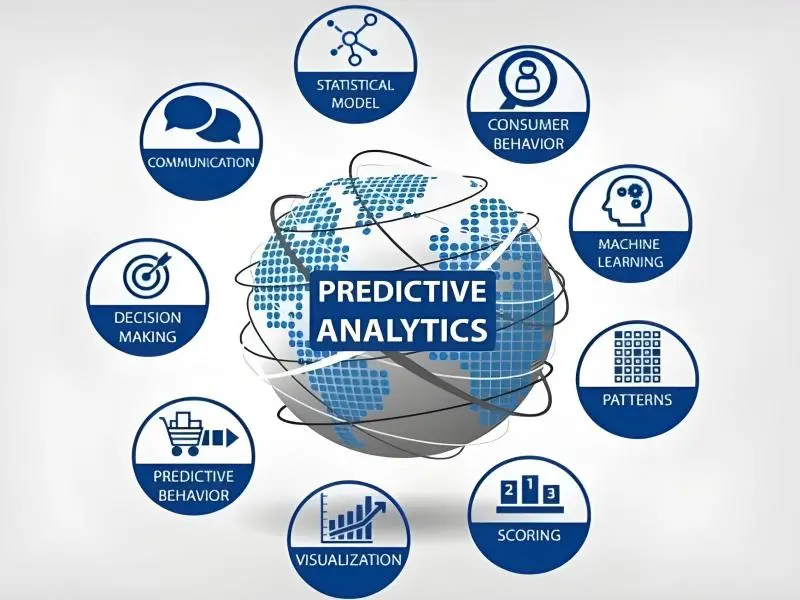- Predictive analytics is a data analysis technique aimed at predicting future events or outcomes.
- Predictive analytics is a powerful tool that helps organisations predict future events, optimise decisions, and enhance efficiency.
Predictive analytics has become an essential tool in today’s business and scientific world. This powerful tool leverages historical data, statistical algorithms, and machine learning techniques to predict future outcomes and trends. It enables businesses to make proactive, data-driven decisions rather than relying solely on past experiences or intuition. By understanding patterns and trends within data, predictive analytics helps organisations anticipate future events, optimise operations, and drive strategic initiatives.
What is predictive analytics?
Predictive analytics is a data analysis technique aimed at predicting future events or outcomes. It combines data mining, statistical models, and machine learning algorithms to analyse historical data and uncover hidden correlations and patterns to make predictions about future events. The goal of predictive analytics is to help organisations make more informed decisions, optimise business processes, and maximise the use of data resources.
Also read: The crystal ball of the digital age: Predictive analytics
Also read: 6 examples of intelligent automation
How does predictive analytics work?
Data analysis: Data analysis is the foundation of predictive analytics, starting with a comprehensive examination of data to uncover patterns and trends. By analysing historical data, organisations can gain insights into past behaviours and performance, laying the groundwork for predictive modelling.
Model development: Next comes model development, where statistical models and machine learning algorithms are created to process the data and generate predictions. These models are trained using historical data, allowing them to identify underlying patterns that lead to specific outcomes. Through this process, organisations can anticipate future events with greater accuracy.
Prediction: Once the models are trained and validated, they are deployed to make predictions about future events. This can range from forecasting sales trends and predicting customer churn to anticipating equipment failures. By leveraging predictive analytics, organisations can proactively address potential challenges and seize opportunities before they arise.
Actionable insights: The ultimate goal of predictive analytics is to convert these predictions into actionable insights that drive decision-making and strategy. By translating the data-driven forecasts into practical guidance, organisations can optimize their operations, enhance customer experiences, and stay ahead of the competition. Whether it involves adjusting marketing strategies, improving customer service processes, or optimising supply chain operations, actionable insights derived from predictive analytics empower organisations to make informed and strategic decisions. By integrating predictive analytics into their workflows, organisations can unlock new possibilities and drive greater success in an increasingly data-driven world.
Applications of predictive analytics
Business and finance: Predictive analytics is widely used in finance for fraud detection, risk assessment, and investment strategies. In business, it helps in demand forecasting, customer segmentation, and sales predictions.
Healthcare: In healthcare, predictive models can predict disease outbreaks, patient outcomes, and treatment responses, leading to improved patient care and resource allocation.
Retail: Retailers use predictive analytics for inventory management, personalised marketing, and customer behaviour analysis to enhance the customer experience and increase sales.
Manufacturing: Manufacturers rely on predictive analytics for quality control, supply chain optimisation, and maintenance scheduling to reduce downtime and improve efficiency.
The importance of predictive analytics
Predictive analytics plays a pivotal role in shaping the strategic decisions of organisations by providing data-driven insights that transcend intuition and historical precedents. This capability is crucial for risk management, as it enables businesses to foresee potential risks and mitigate losses before they materialise. Moreover, the operational efficiency gained from predictive models is significant, as they pinpoint areas for improvement and streamline processes, thereby reducing waste and enhancing overall productivity.
Furthermore, predictive analytics is instrumental in enhancing customer satisfaction. By deciphering customer behaviour and anticipating their needs, organisations can tailor their services and offerings to align with customer expectations, leading to a more personalised and satisfying experience. This customer-centric approach not only fosters loyalty but also drives business growth and innovation.

